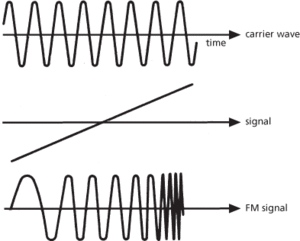See modulation; radio.
The encoding of information transmitted by a carrier wave, e.g. a radio signal, by varying the frequency of the carrier wave while leaving the wave amplitude constant.
See modulation. See also disk format.
The dispatch of signals over a transmission line by changing the frequency of the wave that carries the signal.
A type of modulation in which the frequency of the carrier wave is varied above and below its unmodulated value by an amount proportional to the amplitude of the signal wave and at a frequency of the modulating signal, the amplitude of the carrier wave remaining constant (see diagram). If the modulating signal is sinusoidal then the instantaneous amplitude, e, of the frequency-modulated wave may be written:
where Em is the amplitude of the carrier wave, F the unmodulated carrier wave frequency, ΔF the peak variation of the carrier-wave frequency from F due to modulation, and f is the modulating signal frequency. ΔF is called the frequency swing and the maximum value (ΔFmax) of the frequency swing for which the system has been designed is the frequency deviation. The deviation ratio is defined as ΔFmax/fmax; the modulation index, β, is given by ΔF/f. If the total bandwidth occupied by the transmission is less than 30 kilohertz, the transmission is said to be narrowband FM.
If the modulating signal is not sinusoidal but is made up of discrete levels, the resulting modulation is known as frequency shift keying (FSK). Any number of discrete-amplitude signal levels can be used. If only two levels are used, the result is binary FSK. In binary FSK the carrier is frequency modulated by two different sinusoidal signals representing either a one or a mark, and a zero or a space (see mark). The two frequencies are commonly separated by 85 Hz in narrowband FSK and by 850 Hz in wideband FSK. This two-tone modulation is commonly used in telegraphy systems. In the general case where M discrete levels of the modulating signal are used, the modulation is called M-ary FSK. The rate of switching between the different frequencies affects the system performance; rapid switching is known as fast hopping.
Frequency modulation has several advantages over amplitude modulation, the most important being the improved signal-to-noise ratio. See also pulse modulation; phase modulation.

Frequency modulation
http://www.radio-electronics.com/info/rf-technology-design/fm-frequency-modulation/what-is-fm-tutorial.php A tutorial on frequency modulation
- diplograptids
- diploid
- diplomonad
- diplont
- Diplopleurozoa
- Diplopoda
- Diploporita
- diplotene
- Diplura
- dipmeter log
- dip moveout
- Dipneusti
- Dipnoi
- dipolar bond
- dipole
- dipole antenna
- dipole field
- dipole radiation
- dipole–dipole interaction
- Diponegoro (1785–1855)
- DIPP
- dipper
- dip pole
- dip shooting
- dip-slip fault